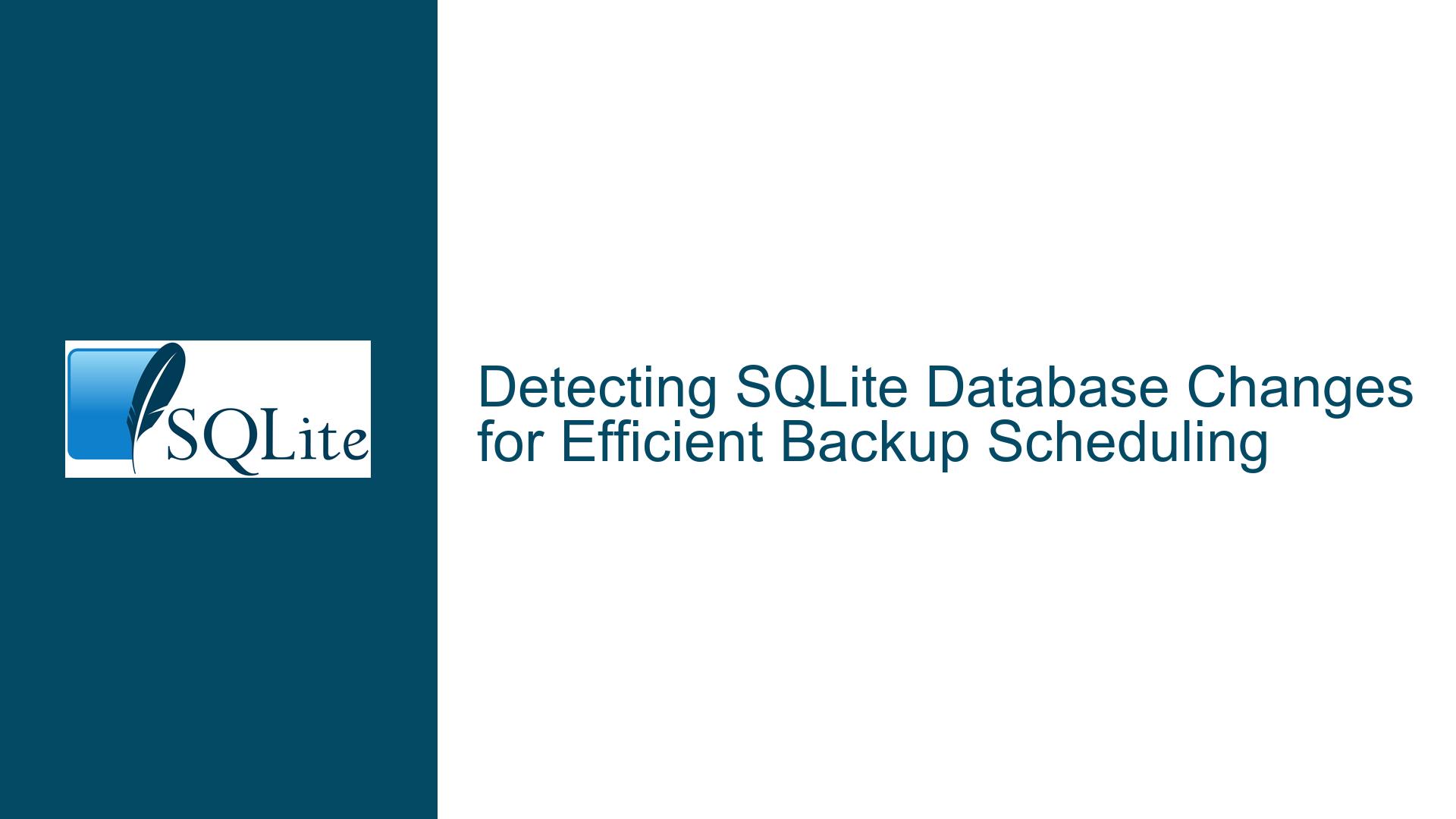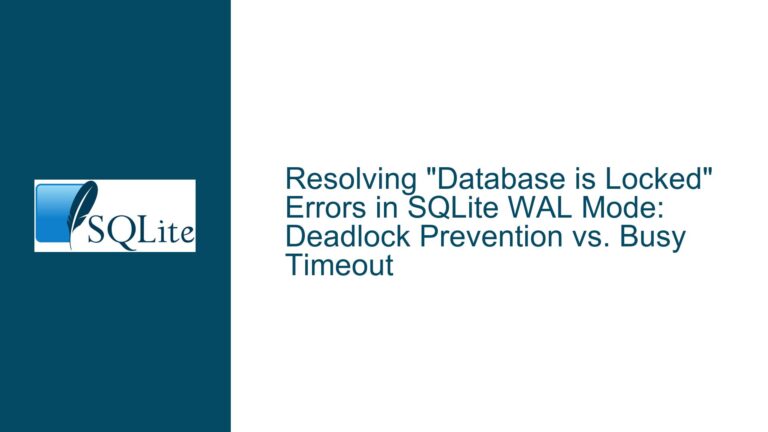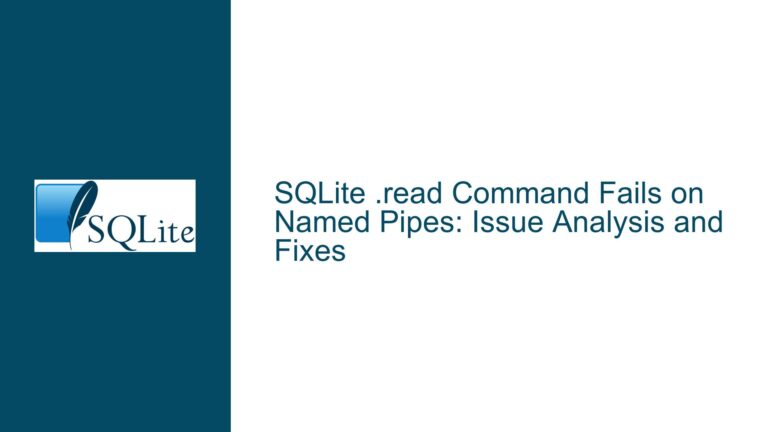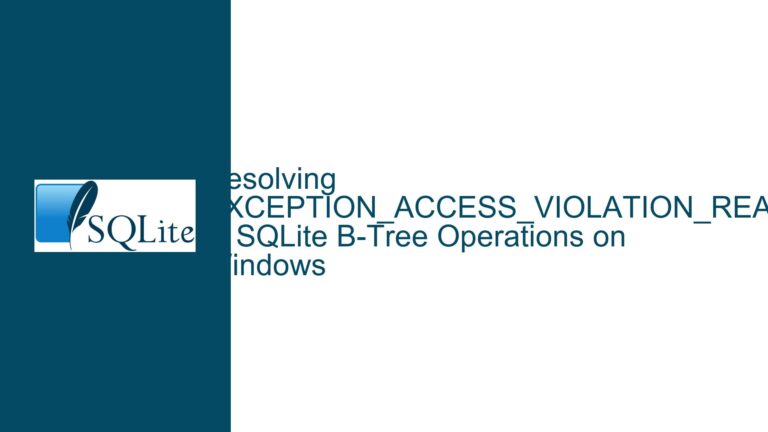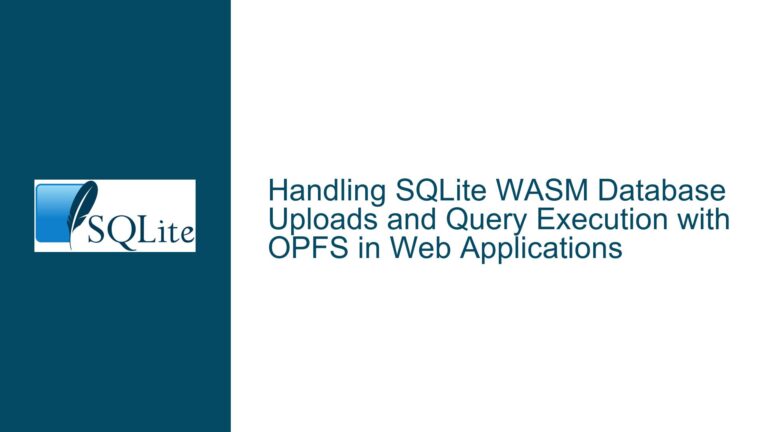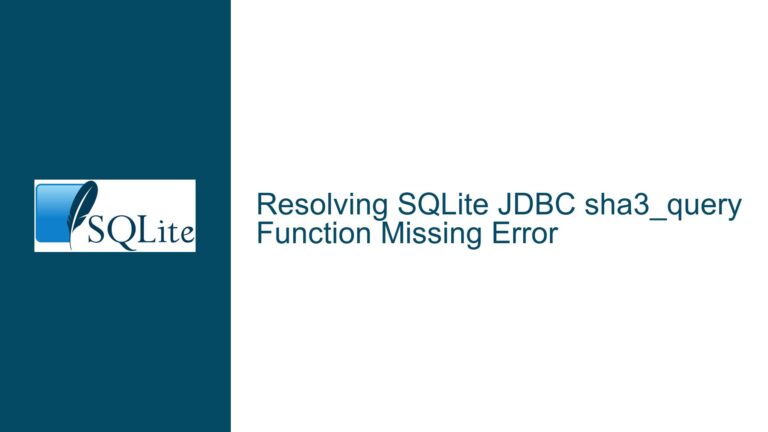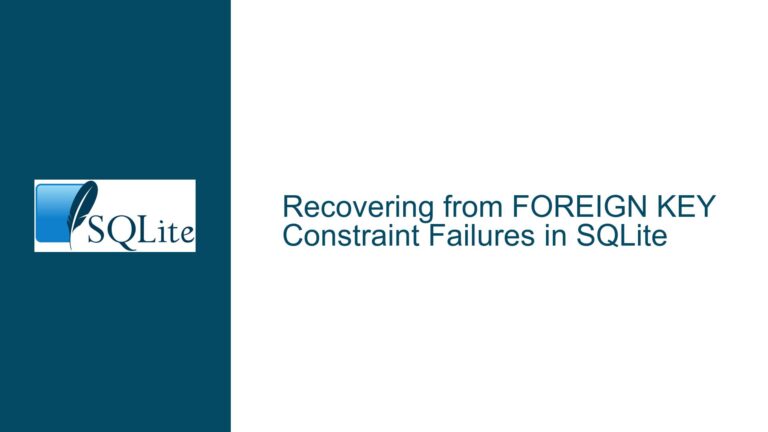Detecting SQLite Database Changes for Efficient Backup Scheduling
Understanding the Challenge of Reliable Database Change Detection in Backup Systems
The core challenge in this scenario revolves around determining whether a SQLite database file has undergone substantive changes since its last backup to cold storage. This requirement emerges in multi-tenant environments where numerous databases require periodic archiving without wasting resources on redundant backups. The fundamental tension lies between accuracy guarantees and computational efficiency: while cryptographic hashes provide absolute confidence in data integrity, they impose significant I/O overhead for large databases. Conversely, lighter-weight methods like file modification timestamps or internal version counters carry risks of false positives/negatives.
At architectural level, three critical constraints shape viable solutions:
- Connection Independence: Detection mechanisms must remain valid across application restarts and connection closures
- Write-Ahead Log (WAL) Compatibility: Solutions must account for SQLite’s alternative journaling mode that alters change tracking behavior
- Cold Storage Requirements: Backup targets likely impose write-once semantics, preventing incremental updates and necessitating full dataset comparisons
This tripartite challenge eliminates simplistic approaches like persistent connection maintenance or filesystem metadata reliance. Production-grade implementations require layered strategies combining multiple verification techniques with fail-safes against edge cases.
Architectural Limitations of Native SQLite Change Tracking Mechanisms
Data Version Pragmas and Their Ephemeral Nature
The PRAGMA data_version command returns a 32-bit integer incremented after each transaction that modifies the database. While seemingly ideal for change detection, its value resets unpredictably when:
- Database connections close
- WAL checkpoints occur
- Schema modifications alter internal B-tree structures
- VACUUM operations reorganize storage
In WAL mode particularly, data_version exhibits non-monotonic behavior because multiple concurrent readers can exist without triggering version increments. This makes it unsuitable for cross-connection comparisons. A test case demonstrates the issue:
-- Connection 1
PRAGMA journal_mode=WAL;
BEGIN;
CREATE TABLE test1(id INTEGER);
COMMIT;
PRAGMA data_version; -- Returns X
-- Connection 2 (same database)
BEGIN;
CREATE TABLE test2(id INTEGER);
COMMIT;
PRAGMA data_version; -- Returns X+1 in default mode but may show X in WAL
File Change Counter in Page 1 Header
The SQLite file format reserves bytes 24-27 of the database header for a 32-bit change counter incremented on each commit in rollback journal mode. While accessible via the sqlite_dbpage virtual table when enabling the DBPAGE extension, this mechanism fails under WAL:
-- Enable required extension
SELECT load_extension('sqlite3_dbpage');
CREATE VIRTUAL TABLE temp.dbpage USING dbpage;
-- Read change counter from page 1
SELECT HEX(substr(data,25,4)) FROM temp.dbpage WHERE pgno=1;
In WAL mode, the change counter only updates when page 1 itself gets modified. Since WAL transactions append to the write-ahead log rather than modifying main database pages, most commits leave the change counter stale. This creates false negatives where active database changes go undetected.
Schema Modification Tracking Pitfalls
While schema changes (table/index creation) do modify the sqlite_schema table and could theoretically be tracked via triggers, this approach misses critical data alterations:
-- Create schema change log table
CREATE TABLE schema_changes (
change_time DATETIME DEFAULT CURRENT_TIMESTAMP,
sql_text TEXT
);
-- Trigger to capture DDL statements
CREATE TRIGGER schema_trigger AFTER CREATE
ON sqlite_schema BEGIN
INSERT INTO schema_changes(sql_text) VALUES (sqlite_sql());
END;
This successfully logs CREATE TABLE/INDEX statements but provides no visibility into INSERT/UPDATE/DELETE operations. Comprehensive tracking would require per-table triggers imposing untenable overhead:
-- Example data change trigger (must be created per table)
CREATE TRIGGER data_trigger AFTER UPDATE ON users
BEGIN
UPDATE change_log SET last_modified = STRFTIME('%s','now') WHERE table_name='users';
END;
Comprehensive Strategy for Change Detection and Backup Integrity
Layered Verification Protocol
Implement a multi-stage verification pipeline that progresses from lightweight checks to resource-intensive validations:
Filesystem Metadata Filter
- Compare
mtime/ctimeagainst last backup timestamp - Account for clock drift via NTP synchronization
- Use nanosecond-precision timestamps where supported
- Example shell check:
last_backup=$(stat -c %Y backup.sqlite) current_mtime=$(stat -c %Y live.sqlite) if (( current_mtime > last_backup )); then trigger_backup fi
- Compare
Header-Based Change Indicators
- Read database header without full connection
- Parse both change counter and WAL status:
import struct with open('database.sqlite', 'rb') as f: header = f.read(64) change_counter = struct.unpack('>I', header[24:28])[0] wal_mode = header[18] == 0x02
Content Sampling with Probabilistic Checking
- Perform partial hash comparisons on randomly selected pages
- Configure sample rate based on database size:
-- Get total pages PRAGMA page_count; -- Sample 1% of pages minimum 10, maximum 1000 WITH sampled_pages AS ( SELECT * FROM generate_series(1, (SELECT page_count FROM pragma_page_count())) ORDER BY RANDOM() LIMIT MAX(10, (SELECT page_count FROM pragma_page_count()) / 100) ) SELECT sha3sum(page) FROM dbpage WHERE pgno IN sampled_pages;
Full Database Hashing with Parallelism
- Leverage SQLite’s built-in SHA3 implementation
- Optimize via memory-mapped I/O and batch processing:
PRAGMA mmap_size=1073741824; -- 1GB memory mapping SELECT hex(sha3sum(data)) FROM sqlite_dbpage;
Transactionally-Safe Backup Capture
To prevent partial writes from corrupting backups, combine copy operations with SQLite’s backup API:
// C example using backup API
sqlite3_backup *backup = sqlite3_backup_init(dest_db, "main", source_db, "main");
if(backup){
do {
rc = sqlite3_backup_step(backup, 100); // Copy 100 pages per step
remaining = sqlite3_backup_remaining(backup);
pagecount = sqlite3_backup_pagecount(backup);
progress = ((pagecount - remaining)*100)/pagecount;
} while(rc == SQLITE_OK || rc == SQLITE_BUSY || rc == SQLITE_LOCKED);
sqlite3_backup_finish(backup);
}
For filesystem-level copies without C integration, use copy-on-write reflinks where supported (Btrfs, APFS, XFS):
cp --reflink=always database.sqlite backup.sqlite
WAL-Aware Change Detection
When databases operate in WAL mode, supplement standard checks with WAL file analysis:
Check WAL file existence and size:
wal_size=$(stat -c %s database.sqlite-wal 2>/dev/null || echo 0) if [[ $wal_size -gt 0 ]]; then echo "Uncheckpointed WAL present" fiParse WAL header for committed frames:
def parse_wal_header(wal_file): header = wal_file.read(32) magic = header[0:4] version = int.from_bytes(header[4:8], 'big') page_size = int.from_bytes(header[8:12], 'big') checkpoint_seq = int.from_bytes(header[12:16], 'big') salt = header[16:24] checksum = header[24:32] return { 'frame_count': (os.path.getsize(wal_file.name)-32)//(page_size+24) }Force periodic checkpoints in WAL mode:
PRAGMA wal_checkpoint(TRUNCATE);
Hybrid Backup Strategies
Combine full database copies with incremental WAL archiving for point-in-time recovery:
Initial full backup:
sqlite3 database.sqlite ".backup backup.sqlite"Continuous WAL archiving:
PRAGMA wal_checkpoint; mv database.sqlite-wal wal_archives/$(date +%s).walRestore process:
cp backup.sqlite restored.sqlite cat wal_archives/*.wal | sqlite3 restored.sqlite
Performance Optimization Techniques
Memory-Mapped I/O for Hashing
PRAGMA mmap_size=1073741824; -- 1GB mapping
SELECT sha3sum(data) FROM sqlite_dbpage;
Parallel Page Processing
Utilize worker threads to compute partial hashes:
from concurrent.futures import ThreadPoolExecutor
def hash_page(page_data):
return hashlib.sha3_256(page_data).digest()
with ThreadPoolExecutor() as executor:
page_hashes = list(executor.map(hash_page, pagelist))
Incremental Hashing with Merkle Trees
Build hierarchical hashes allowing partial validation:
Level 3: Root Hash (hash of level2 hashes)
Level 2: Hash 1-1000 | Hash 1001-2000 | ...
Level 1: Page 1 Hash | Page 2 Hash | ... | Page N Hash
Compression-Aware Backups
Precompress database pages prior to archival:
INSERT INTO cold_storage SELECT zlib_compress(data) FROM sqlite_dbpage;
Failure Mode Analysis and Mitigation
False Positives in Change Detection
- Cause: Filesystem timestamp updates without data changes
- Fix: Combine mtime checks with header validation
False Negatives in WAL Mode
- Cause: Uncheckpointed changes in WAL file
- Fix: Implement WAL size monitoring and forced checkpoints
Backup Corruption Risks
- Cause: Partial writes during direct file copy
- Fix: Use SQLite Online Backup API or copy-on-write reflinks
Clock Skew Issues
- Cause: Server time changes invalidating mtime comparisons
- Fix: Maintain monotonic backup clocks via NTP and sanity checks
Storage of Verification Metadata
- Challenge: Securely persisting hashes/versions between backups
- Solution: Store metadata in separate SQLite database with write-ahead logging disabled
Implementation Checklist for Production Systems
- Enable DBPAGE Extension for direct page access
- Configure Mandatory Checkpointing for WAL databases
- Implement Hybrid Verification:
- Stage 1: mtime + file size check
- Stage 2: Header change counter validation
- Stage 3: 1% random page sampling
- Stage 4: Full SHA3-256 hash (fallback)
- Deploy Copy-on-Write Filesystem for atomic snapshots
- Monitor False Positive Rates with historical analysis
- Schedule Full Validations during low-utilization periods
- Maintain Cold Storage Index with cryptographic proofs
This comprehensive approach balances computational efficiency with rigorous change detection, adapting to SQLite’s operational modes while preventing backup corruption. By layering multiple verification stages and employing modern filesystem features, systems can achieve reliable cold storage archival without excessive resource consumption.
